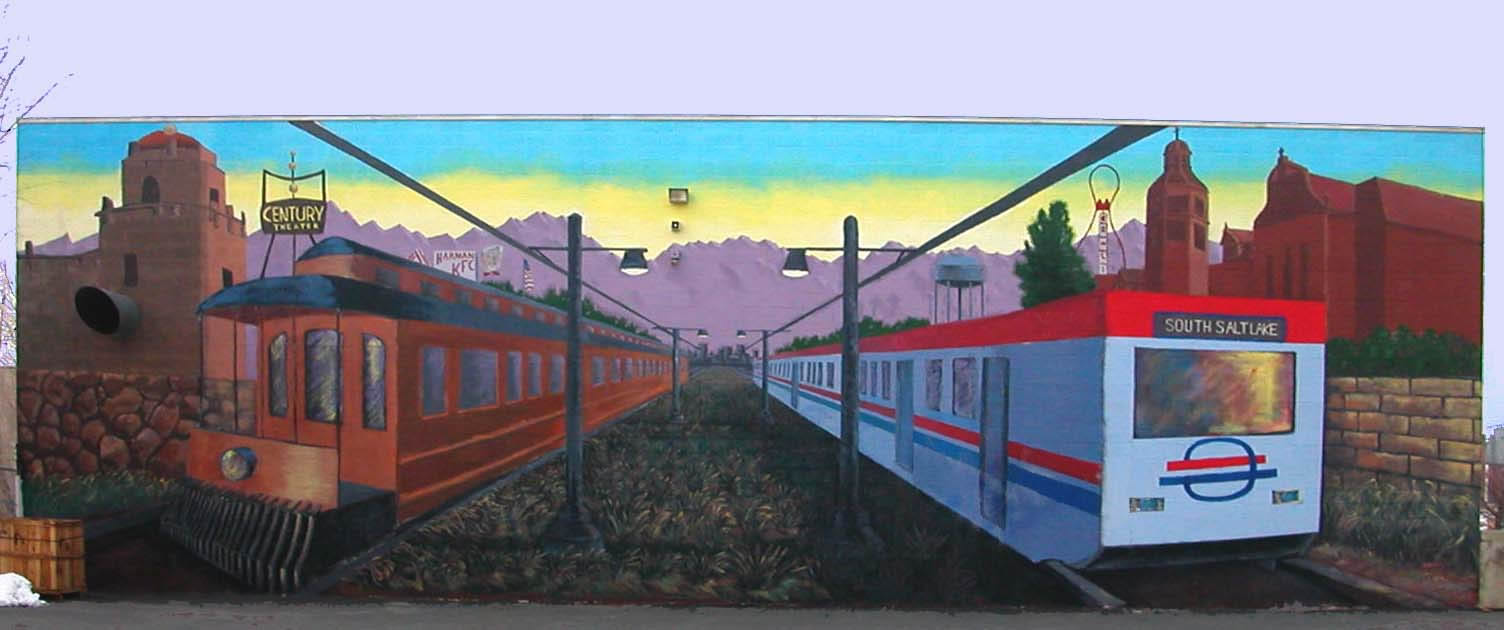
May 19, 2004 — Now, while waiting for public transportation, South Salt Lake City commuters can contemplate public art, thanks to the creative work and learning experiences of seven University of Utah painting and drawing students. Nearby 2100 S. and the 3300 S. Millcreek TRAX line are two large-scale murals, painted with the goal of “bonding the community.” One is a 25- by 60-foot trompe l’oeil (“fool-the-eye” or “illusion” painting), which juxtaposes two trains-a historic trolley and a TRAX train-coming toward the viewer at twilight. Historic buildings of the surrounding area-the Century Theater, Harmon’s Kentucky Fried Chicken and some that no longer exist-are painted in the background. The other mural, a hardedge painting, is a bird’s eye view of passengers waiting for a train, reading and conversing-all set against a bright yellow background.
From concept to completion, the project was part of a course on painting murals, taught last fall semester by Kim Martinez, an assistant professor of painting and drawing in the University’s Department of Art and Art History. The class provided students the opportunity to create and execute site-specific painted murals to beautify the TRAX corridor. This public art project gave the students valuable experience for future careers in art, including the challenges of working in a collaborative environment, large scale painting, presenting conceptual ideas and compositions and creating art within the parameters of a public art project. The students, all undergraduates, studied public art and researched the neighborhood surrounding the South Salt Lake TRAX line. They then pitched their ideas to South Salt Lake City Parks and Recreation Manager Tim Williams, Mayor Wes Losser and to the South Salt Lake City Council, “so they learned to talk about their work in a public forum,” Martinez explains, adding that all three entities were very supportive of the project. The students created maquettes, or small, hand-painted studies that they used to generate computer versions of their designs, which added a technology component to the course.
Two companies, Gritton & Associates, located at 235 W. 2950 S., and Manness Sheet Metal, located at 211 W. Gregson Ave. (3052 S.), donated the use of their buildings as “canvases,” chose the final designs and agreed to leave the murals up for at least five years. Both cinderblock buildings were primed and then painted with ordinary, exterior house paint, donated by area paint stores. “They gave us the colors that we needed, but the other colors we wanted we mixed ourselves. If a tree needed to be a certain green we would take yellow and blue, adjust the intensity with red to get the green we wanted,” explains Martinez, recipient of the 2003 Mayors Visual Artist Award. Finally, an acrylic paint that filters out ultra violet rays was added to slow the fading of the scenes.
The art took nearly a year to complete because a number of legal, safety and financial issues had to be addressed before painting could begin. Besides the in-kind donations of space, ladders, scaffolding and supplies, the two projects cost about $1,000.
As part of the beautification of the TRAX line, the artists were paid a small amount of money from South Salt Lake City for their labors, funds that were used last week to travel to and view public art-the Byzantium: Faith and Power (1261-1557) at the Metropolitan Museum of Art, The Cloisters, Museum of Modern Art/Queens, the Whitney Biennial, and The Frick collection-in New York City. “The students had a great time and are still recovering from the fast pace of the trip and the energy of the city,” Martinez says.
“It’s important for a visual artist to see what a Goya or Rembrandt looks like in real space,” notes Martinez, adding that the art department will offer the course again this fall.
“Painting these murals gave students the opportunity to get out there and practice in the real world concepts we have been teaching them here in the classroom,” Martinez says. During the painting phase of the project, students met on-site where they worked 12 to 15 hours a week.
This was the first mural class for senior art student Amanda Hansen, who, along with classmate Robin Luker, created one of the two winning designs, the mural comparing the old and new TRAX line landmarks. “Our design was the most site-specific and, with its landmarks, was identifiable to the community, which passes by the real sites. Our design was detailed, with chiaroscuro-more realistic in perspective,” says Hansen. “A lot of time and effort went into setting up this project. And Kim made sure that we understood what we were doing-we were making the mural for the community and about the community.”
